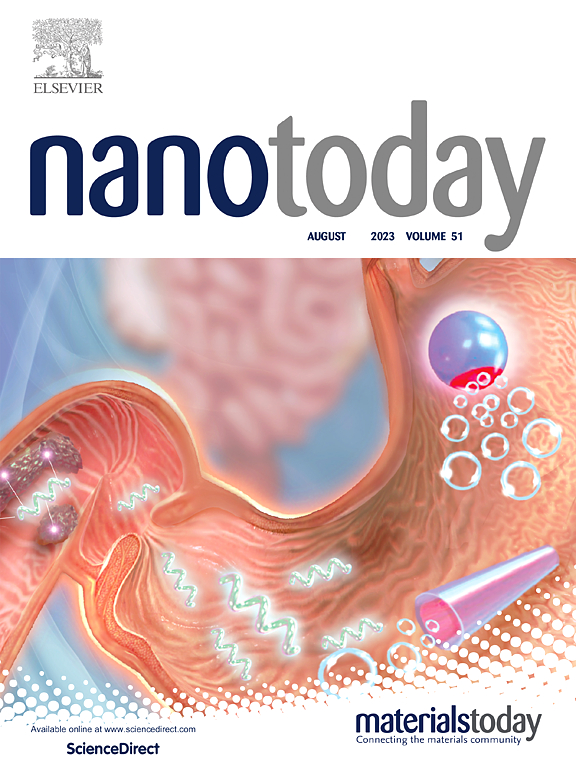微生物对低浓度反位缺陷LiFePO4促进锂离子捕获
IF 10.9
1区 材料科学
Q1 CHEMISTRY, MULTIDISCIPLINARY
引用次数: 0
摘要
LiFePO4 (LFP)被认为是一种很有前途的捕获锂离子(Li+)的电极材料;然而,LFP晶体中反位缺陷的存在阻碍了沿b轴的一维(1D)扩散通道,从而减慢了Li+的扩散并损害了循环稳定性。在此,我们提出了一种“微生物酶催化”的绿色合成策略,成功制备了具有低浓度反位缺陷的多态lfp (<;3 %),从而增强离子传输和稳定的循环性能。低浓度的反位缺陷LFP提供了一个光滑的离子扩散通道,增强了Li+的扩散和电子传递,有效地改善了动力学。此外,来自多磷细菌的碳壳提高了电导率,并为LFP的体积膨胀提供了空间,最终提高了循环稳定性。因此,LFP@C-7具有优异的Li+捕获能力(3.05 mmol g−1)和速率(1.01 mmol g−1min−1),具有较高的分离因子212 (Mg/Li比为60)和优异的循环稳定性(100次循环后容量保持率超过83.3 %)。电化学石英晶体微天平(EQCM-D)分析通过LFP@C-7证实了Li+捕获过程中的水化、离子交换和脱附三阶段反应。此外,原位x射线衍射(XRD)证实了Li+插入和萃取过程中存在FePO4→LiFePO4→FePO4的可逆相变机制。本研究为低浓度反位缺陷LFP的绿色合成提供了一种新的可行方案。本文章由计算机程序翻译,如有差异,请以英文原文为准。
Microbial of low-concentration antisite defects LiFePO4 for boosting lithium ion capture
LiFePO4 (LFP) is recognized as a promising electrode material for capturing lithium ions (Li+); however, the presence of antisite defects in LFP crystals blocks the one-dimensional (1D) diffusion channel along the b-axis, thereby slowing down Li+ diffusion and compromising cycling stability. Herein, we propose a “microbial enzyme-catalyzed” green synthesis strategy, successfully preparing polymorphic LFPs characterized by a low concentration of antisite defects (< 3 %), resulting in enhanced ion transport and stable cycling performance. The low-concentration antisite defective LFP provided a smooth ion diffusion channel, enhancing both Li+ diffusion and electron transport to effectively improve kinetics. Additionally, the carbon shell derived from polyphosphorus bacteria improved electrical conductivity and provided space to accommodate the volume expansion of LFP, ultimately enhancing cycling stability. Consequently, LFP@C-7 exhibited excellent Li+ capture capacity (3.05 mmol g−1) and rate (1.01 mmol g−1min−1), with a high separation factor of 212 (Mg/Li ratio of 60) and excellent cycling stability (capacity retention exceeding 83.3 % over 100 cycles). Electrochemical quartz crystal microbalance (EQCM-D) analysis confirmed the three-stage reaction of hydration, ion exchange, and desorption during Li+ capture by LFP@C-7. Furthermore, in-situ X-ray diffraction (XRD) demonstrated a reversible phase transition mechanism (FePO4→LiFePO4→FePO4) throughout the Li+ insertion and extraction cycles. This study provides a new feasible solution for the green synthesis of low-concentration antisite defects LFP.
求助全文
通过发布文献求助,成功后即可免费获取论文全文。
去求助
来源期刊

Nano Today
工程技术-材料科学:综合
CiteScore
21.50
自引率
3.40%
发文量
305
审稿时长
40 days
期刊介绍:
Nano Today is a journal dedicated to publishing influential and innovative work in the field of nanoscience and technology. It covers a wide range of subject areas including biomaterials, materials chemistry, materials science, chemistry, bioengineering, biochemistry, genetics and molecular biology, engineering, and nanotechnology. The journal considers articles that inform readers about the latest research, breakthroughs, and topical issues in these fields. It provides comprehensive coverage through a mixture of peer-reviewed articles, research news, and information on key developments. Nano Today is abstracted and indexed in Science Citation Index, Ei Compendex, Embase, Scopus, and INSPEC.
 求助内容:
求助内容: 应助结果提醒方式:
应助结果提醒方式:


